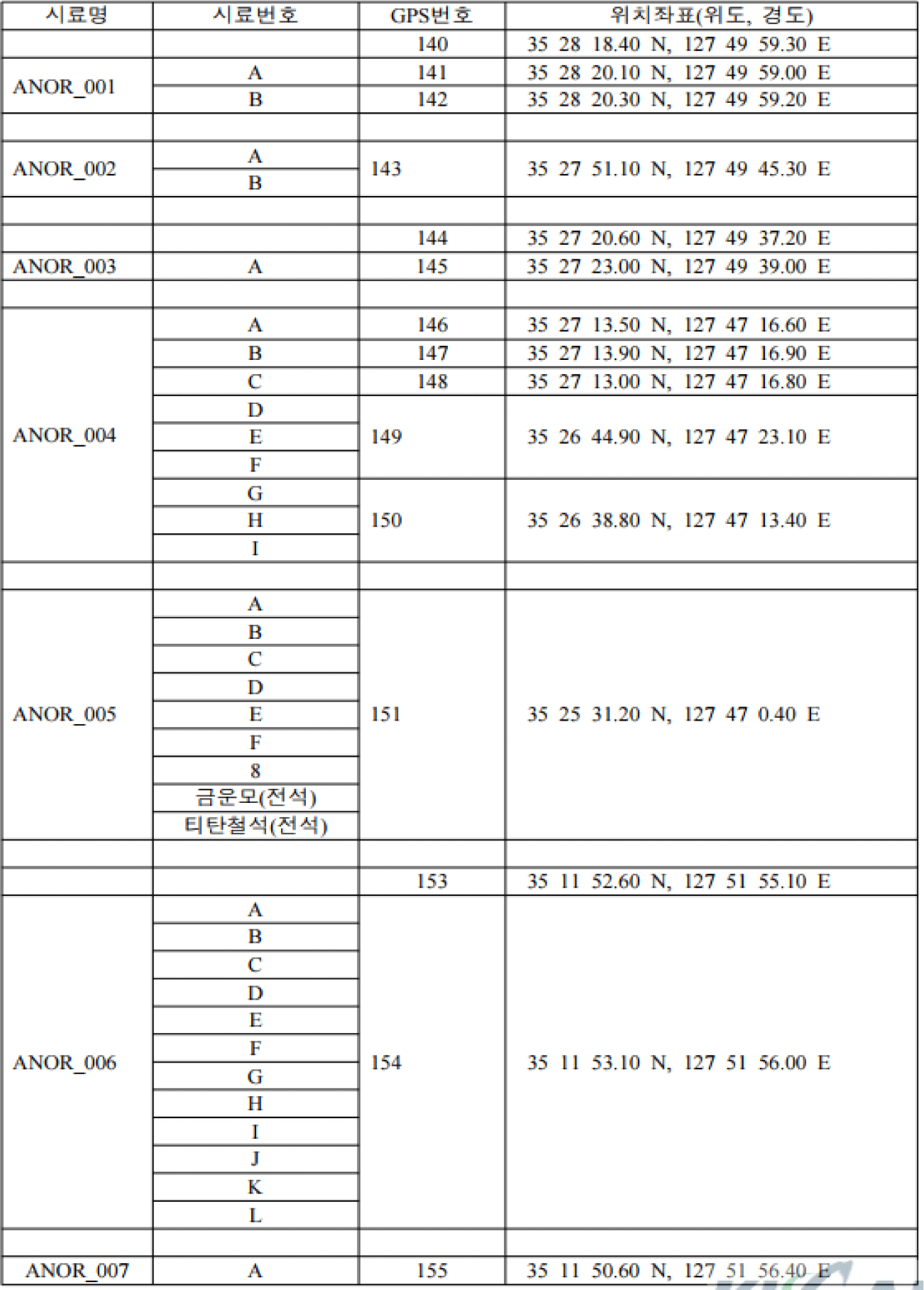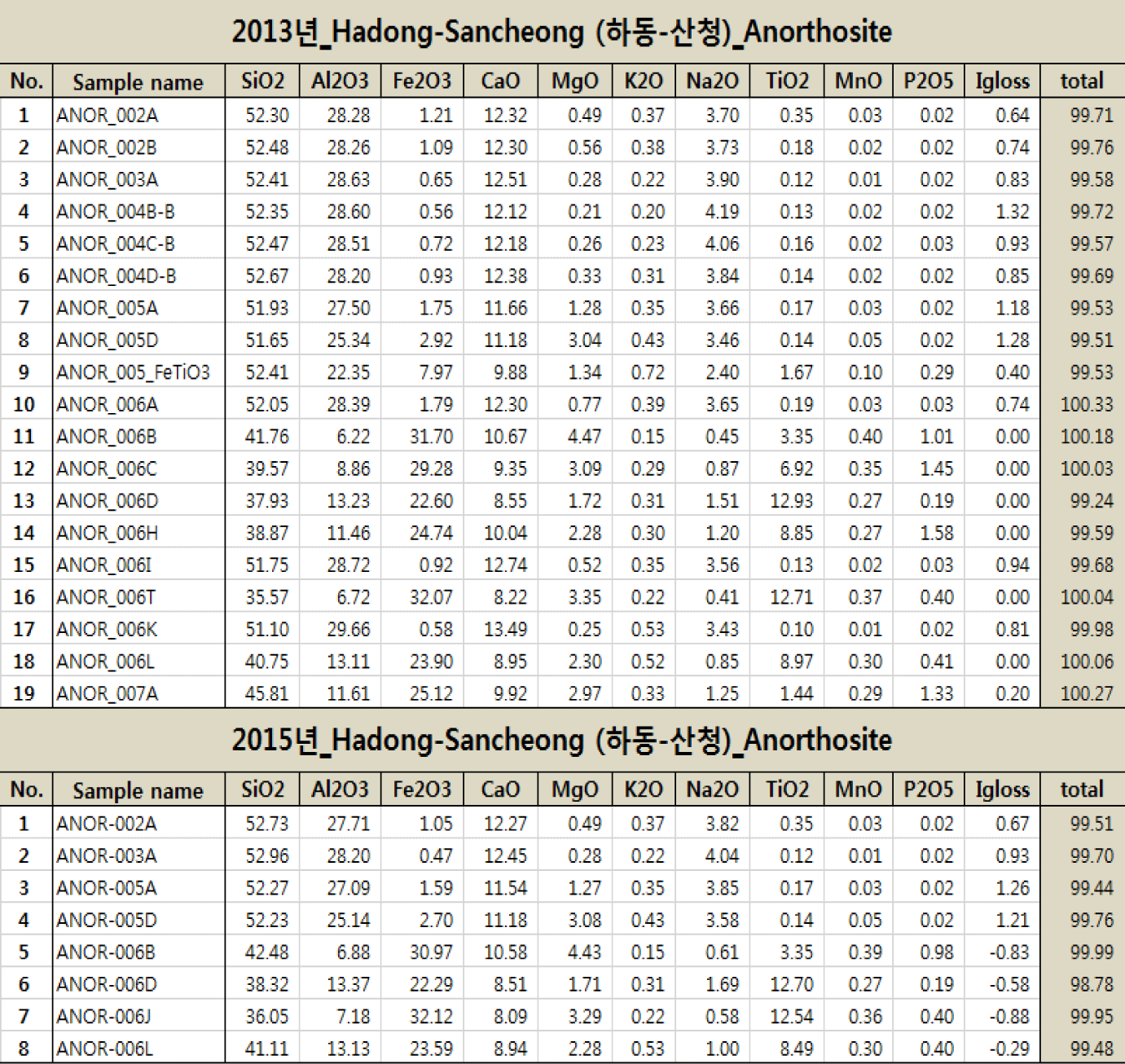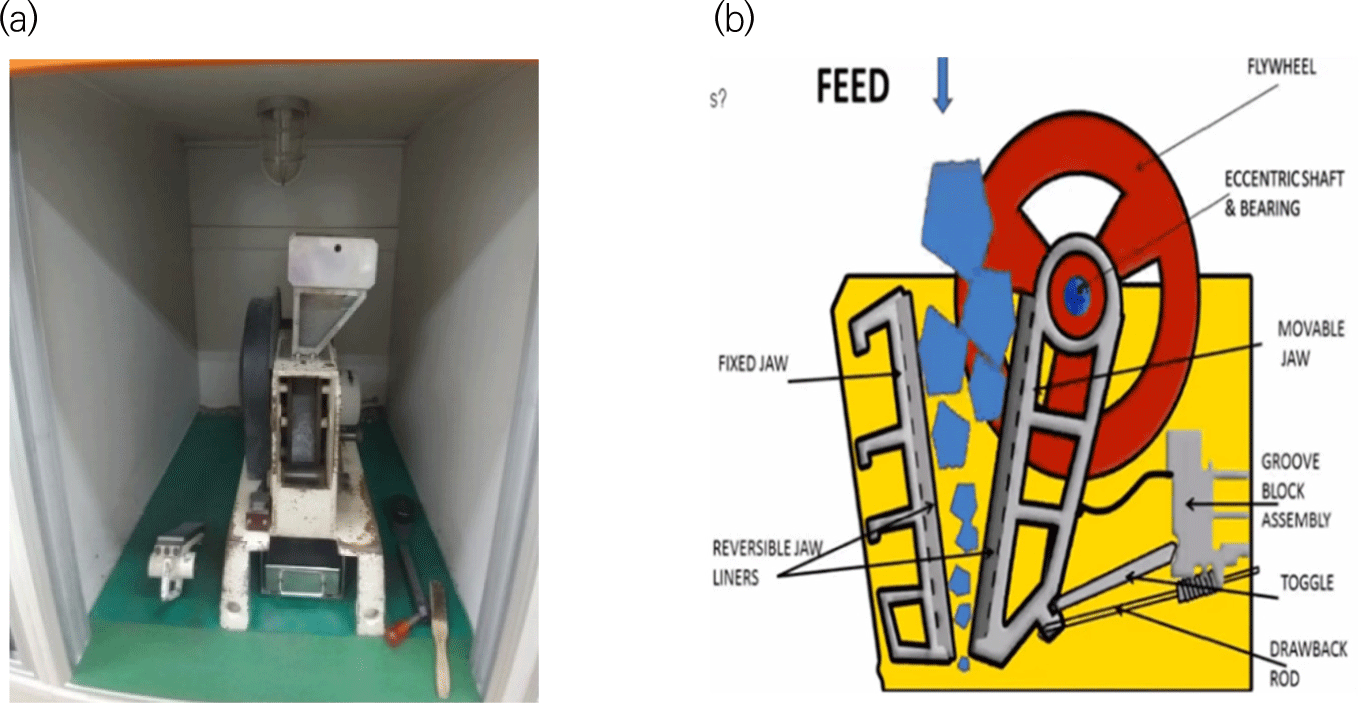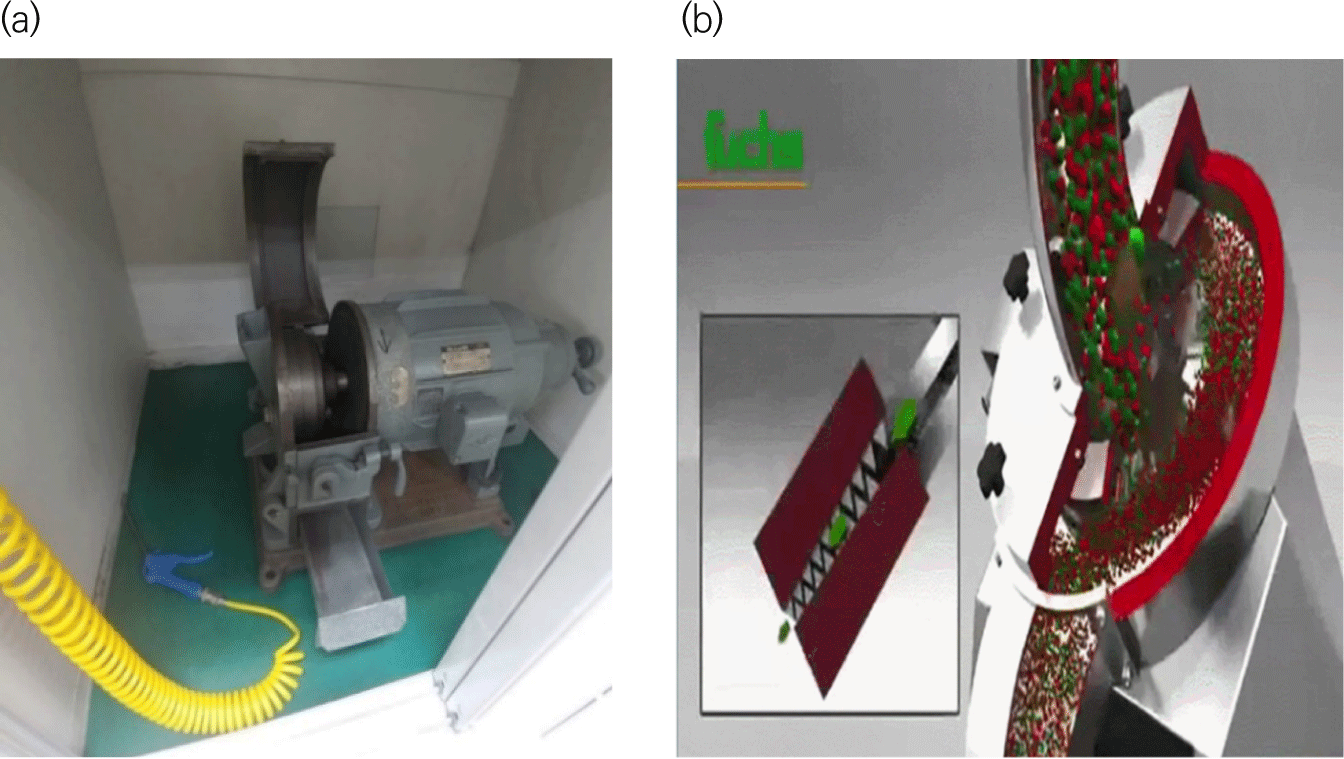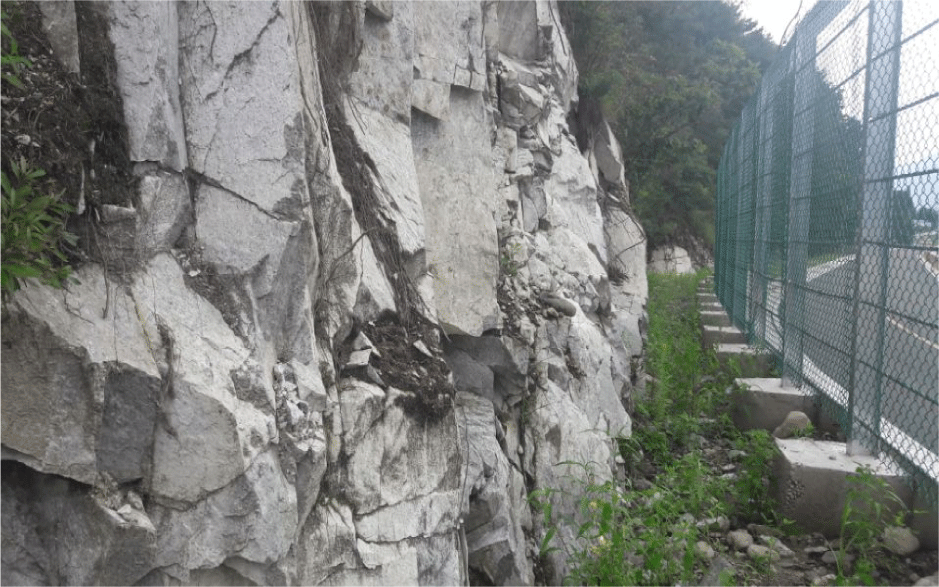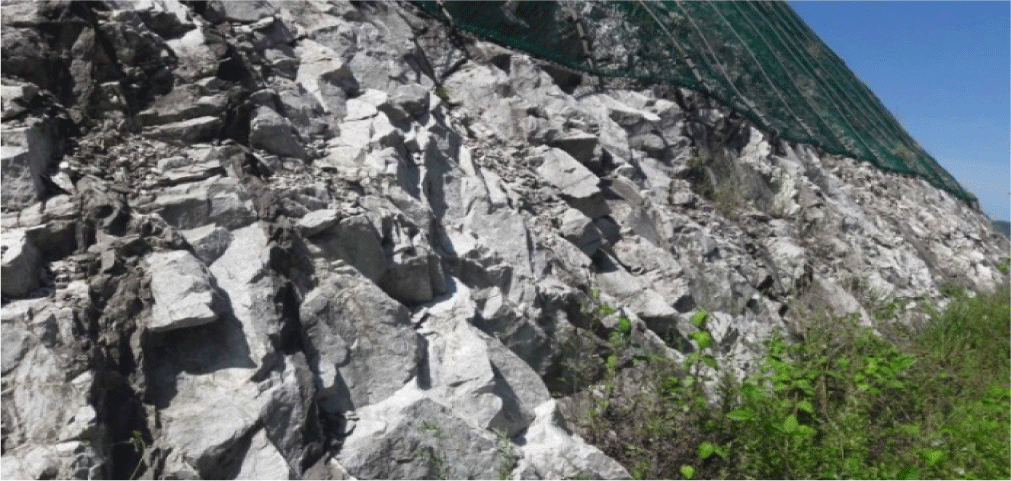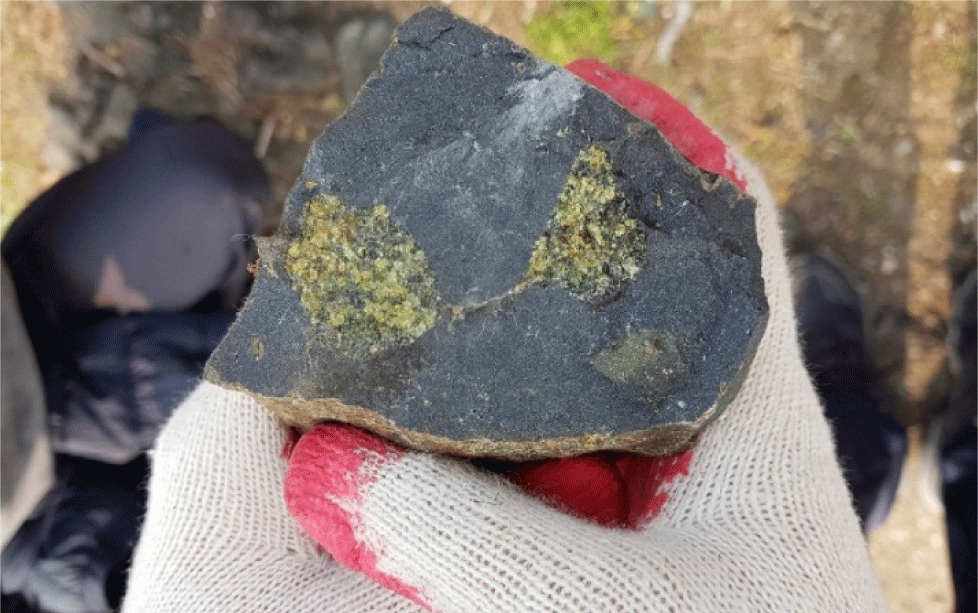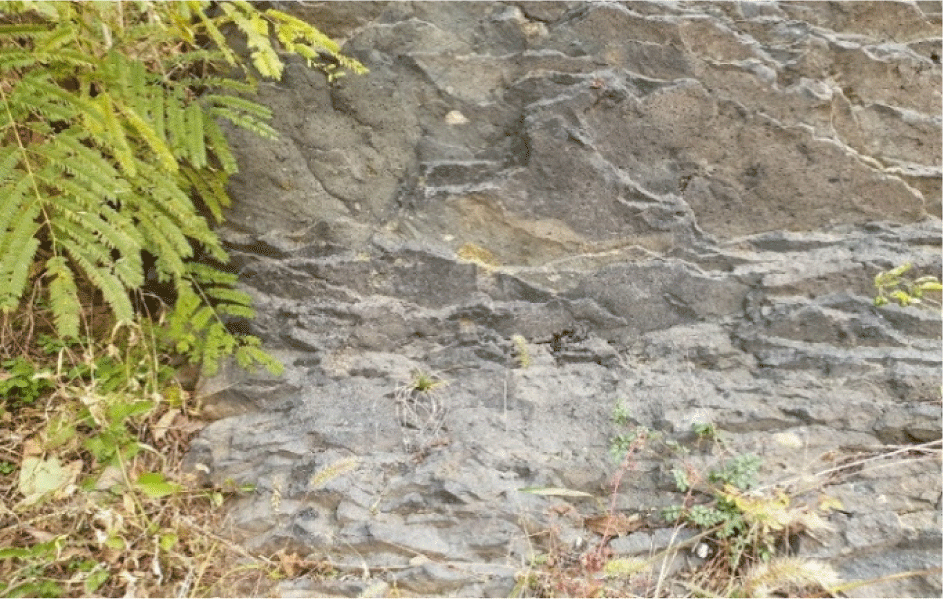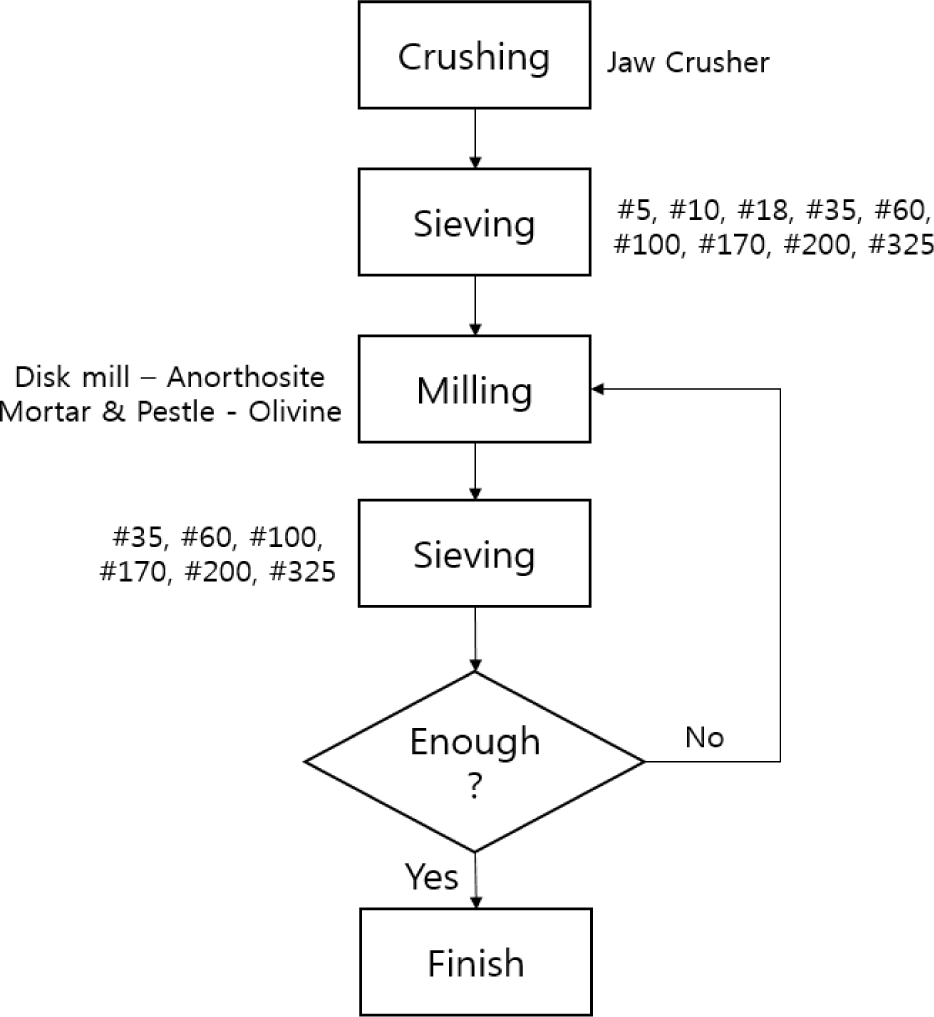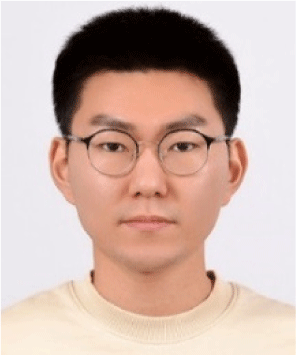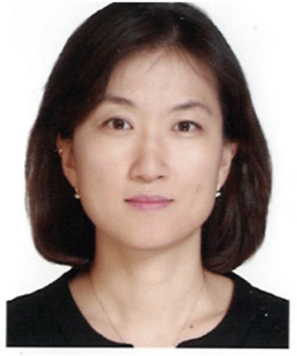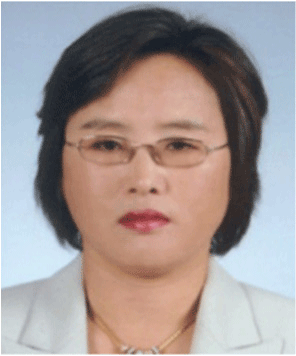연구논문
한국형 달 고원 모사토(KIGAM-L1) 개발
Development of Korean Lunar Highland Soil Simulant (KIGAM-L1)
Tae-Yun Kang
1
, Eojin Kim
2
, Kyeong Ja Kim
3,†
1Department of Astronomy, Space Science and Geology, Chungnam National University, Daejeon 34134, Korea
2Natural Science Research Institute, Chungnam National University, Daejeon 34134, Korea
3Korea institute of Geoscience and Mineral Resources, Daejeon 34132, Korea
†Corresponding author : Kyeong Ja Kim, Tel : +82-42-868-3669, E-mail :
kjkim@kigam.re.kr
© Copyright 2024 The Korean Space Science Society. This is an Open-Access article distributed under the terms of the
Creative Commons Attribution Non-Commercial License (http://creativecommons.org/licenses/by-nc/4.0/) which permits
unrestricted non-commercial use, distribution, and reproduction in any
medium, provided the original work is properly cited.
Received: Apr 14, 2024; Revised: Apr 30, 2024; Accepted: May 02, 2024
Published Online: May 31, 2024
요 약
2022년 8월 발사된 한국형 탐사선(KPLO)이 현재 임무를 성공적으로 수행하고 있으며, 향후 한국의 달 착륙선과 로버 프로그램이 진행될 것으로 기대된다. 달착륙선이 표면에 착륙한 후 임무를 성공적으로 수행하기 위해서는 장착할 장비의 성능을 달과 유사한 실험실 환경에서 점검해야 한다. 이를 위해 달 착륙 지점의 표면을 시뮬레이션하기 위해 미국, 중국 등 여러 나라에서 아폴로 착륙선의 달 토양 샘플과 유사한 달 토양 모사토를 개발하여 사용한다. 국내에서도 여러 달 탐사선 착륙지가 거론되고 있고 달 바다 토양의 특성과 유사한 달 토양 모사토 KOHLS-1(Korea Hanyang Lunar Simulant-1), KAUMLS(Korea Aerospace University Mechanical Lunar Simulants), KLS-1(Korea Lunar Simulant-1)가 개발되었다. 그러나 착륙 장소로 달 고원 지대가 선택될 경우에는 앞의 세 가지 모사토는 유용하지 않다. 본 연구에서는 달 착륙선이 고원 지대에 착륙하는 경우를 대비하여 아폴로 16호 달 토양 샘플의 화학적 조성과 달 토양 샘플 60500-1의 입자 크기 분포를 기준으로 모사하여 달 고지대 토양 모사토 KIGAM-L1을 개발하는 과정을 소개한다.
Abstract
Korea Pathfinder Lunar Orbiter (KPLO), launched in August 2022, is successfully carrying out its mission. Korea's lunar lander and rover programs are expected to proceed in the future. To successfully carry out the mission after the lunar lander has landed on the surface, the performance of the equipment to be mounted should be checked in a laboratory environment similar to the Moon. Scientists and engineers of several countries, including the United States and China, use lunar soil simulant which is developed to resemble lunar soil for simulating the surface of the lunar landing site. Several lunar probe landing sites are being discussed in Korea, and lunar soil simulants such as Korea Hanyang Lunar Simulant-1 (KOHLS-1), Korea Aerospace University Mechanical Lunar Simulants (KAUMLS), and Korea Lunar Simulant-1 (KLS-1), which are similar to the characteristics of lunar mare soil, have been developed. However, those simulants are not useful if the landing site is chosen as a highland area. In this study, we introduce the process of developing KIGAM-L1, a lunar highland soil simulant similar to the chemical composition of the Apollo 16 lunar soil sample and the particle size distribution of lunar soil sample 60500-1, in case the lunar lander lands at highland area.
Keywords: 달 모사토; KIGAM-L1; 달착륙지; 달토양샘플
Keywords: lunar soil simulant; KIGAM-L1; lunar landing site; lunar soil sample
1. 서론
1969년에 달에 도착한 Apollo 유인 우주선 11호와 12호는 달 표면 탐사와 샘플 채취를 성공적으로 마치고 지구에 귀환하였다. NASA는 확보된 달 토양 시료들의 물리적, 지반 공학적, 그리고 화학적 성질 등을 분석한 결과를 바탕으로 달 모사토 LSS(LSS-1–5)를 개발하여 월면차 바퀴 개발 연구에 사용하였다. 이로 인해서 Apollo 15호, 16호, 그리고 17호 우주인들은 월면차를 운행하며 달 표면 탐사 및 시료 채취 미션을 수행할 수 있었다[1].
Apollo 달 토양 귀환 시료 분석을 통해 달 토양이 지구 토양과 비교하여 생성 원인과 약 40억 년 동안 노출된 환경이 크게 다르다는 점과 물리적, 지반 공학적, 그리고 화학적 성질 등에 차이가 있음이 밝혀졌다. 유인 탐사, 로버 탐사, 그리고 달 기지건설은 모두 달 표면을 덮고 있는 표토층 위에서 이루어지기 때문에 달 토양의 성질을 고려한 현지 탐사에 적합한 장비가 개발되어야 한다. 또한 달 기지건설에 사용될 자재와 달에 인류가 거주하는데 필요한 자원 운송에 막대한 비용이 소요되므로, 달 표토에서 자원을 획득하고 건설자재로 가공할 수 있는 ISRU(in situ resource utilization) 연구도 이루어지고 있다. 하지만 현재 인류가 보유하고 있는 달 토양의 양은 약 350 kg에 불과하여, 달 탐사를 진행 중인 국가들은 달 토양과 유사한 달 모사토를 개발하여 사용하고 있다. 현재까지 달 모사토를 자체 개발한 국가들은 미국, 캐나다, 일본, 중국, 한국 그리고 이탈리아이며 미국 NASA Johnson Space Center에서 개발한 JSC-1A(Johnson Space Center-1A)이 현존하는 달 모사토들 중에서 가장 달 토양과 유사하다고 인정받고 있다[1].
한국은 제1차 우주개발진흥 기본계획(2007)에 따라 우주탐사 프로그램이 시작되었고, 2007 우주개발사업 세부 실천 로드맵을 통해 2017년부터 2020년까지 달 탐사 궤도선 개발, 2021년부터 2025년까지 달 탐사 착륙선과 탐사 로버 개발을 목표로 세웠다. 현재 한국은 2022년 8월 발사된 달 시험용 궤도선(Korea Pathfinder Lunar Orbiter, KPLO)이 달 궤도를 돌며 활발하게 관측을 진행하는 중이고 향후 달 착륙선과 탐사 로버 순으로 달 탐사 프로그램을 이어갈 예정이다. 이에 달 착륙 임무를 대비하기 위해 한양대학교, 한국항공대학교, 한국건설기술연구원에서 현무암을 원료로 사용한 달 모사토 KOHLS-1(Korea Hanyang Lunar Simulant-1), KAUMLS(Korea Aerospace University Mechanical Lunar Simulants), KLS-1(Korea Lunar Simulant-1)을 각각 개발하였고 모두 달의 바다에 있는 토양의 성질을 모사하여 개발하였다[2–4]. 향후 달 고원 지역에 달탐사선이 착륙할 경우를 대비하여 본 연구에서는 하동-산청에서 채취한 회장암과 평택-아산 그리고 뉴멕시코 주에서 채취한 감람석을 원료로 사용하여 아폴로 달 토양 샘플 중 하나인 60500-1의 입도분포와 화학구성(Bulk chemistry)을 기준으로 모사한 달 고원 모사토 KIGAM-L1을 개발하는 과정을 소개한다.
2. 달 모사토 개발 현황
달 모사토는 암석, 광물 그리고 합성물질을 원료로 사용하여 달 토양의 물리적, 화학적 성질과 유사하게 개발된 흙이라고 정의된다[5]. 1970년대부터 미국은 Apollo 11, 12호를 통해 확보된 달 표면 샘플 분석 결과를 바탕으로 월면차 개발에 활용하기 위해 캘리포니아에서 채취한 현무암 원료로 LSS(Lunar Soil Simulant)를 개발하였다[1]. 1990년대에 미네소타 대학은 현무암을 원료로 한 MLS-1(Minnesota Lunar Simulant-1)과 일부 원료를 유리로 만들어 섞은 MLS-1P, 반려암을 원료로 한 MLS-2를 개발하였다[6]. 아리조나 대학은 현무암과 금속 물질을 섞어 ALS(Arizona Lunar Simulant)를 개발하였다[7]. 존슨우주센터에서 개발된 JSC-1은 추가로 2005년에 JSC-1A와 JSC-1 원료 중 미세구조 입자만으로 이루어진 JSC-1Af가 개발되었다[8]. 2008년 Goddard Space Flight Center에서 드릴장비 개발 목적으로 휘록암을 원료로 GSC-1(Goddard Space Flight Center-1)을 개발하였다[9] 2010년에는 나사(NASA)와 미국지질조사국(USGS)이 회장암, 감람암, 노라이트, 티탄철석을 원료로 NU-LHT-1M(NASA USGS Lunar Highlands Type-1M)을 개발하였고 NU-LHT-2M는 극지방 탐사를 고려하여 개발되었다[10]. 같은 시기, 콜로라도 대학은 화강암과 현무암 원료로 CSM-CL(Colorado School of Mines – Colorado Lava)을, 글렌연구센터는 모래를 원료로 GRC-1(Glenn Research Center-1)과 GRC-3을 개발하였다. BP-1(Black Point-1)은 아리조나주에서 채취된 흙으로 물리화학적 성분이 달 바다토양과 유사하다[11–13] (Table 1).
Table 1.
A list of lunar regolith (or soil) simulants
|
달 모사토 |
국가 |
년도 |
토양 타입 |
|
LSS |
미국 |
1970년대 |
바다 |
|
MLS-1/1P |
미국 |
1990년 |
바다 |
|
MLS-2 |
미국 |
1992년 |
고원 |
|
ALS |
미국 |
1991년 |
바다 |
|
JSC-1/1A/1Af |
미국 |
1994년 |
바다 |
|
FJS-1/2/3 |
일본 |
1998년 |
바다 |
|
CAS-1 |
중국 |
2005년 |
바다 |
|
OB-1 |
캐나다 |
2005년 |
고원 |
|
GSC-1 |
미국 |
2008년 |
바다 |
|
KOHLS-1 |
한국 |
2009년 |
바다 |
|
NAO-1 |
중국 |
2009년 |
고원 |
|
CSM-CL |
미국 |
2010년 |
바다 |
|
NU-LHT-1M/2M |
미국 |
2010년 |
고원 |
|
TJ-1 |
중국 |
2010년 |
바다 |
|
BP-1 |
미국 |
2010년 |
바다 |
|
GRC-1,3 |
미국 |
2010년 |
- |
|
NAO-2/3 |
중국 |
2011년 |
바다 |
|
CUG-1A |
중국 |
2011년 |
바다 |
|
DNA-1/1A |
이탈리아 |
2014년 |
바다 |
|
KAUMLS |
한국 |
2014년 |
- |
|
TRI-1 |
인도 |
2014년 |
- |
|
KLS-1 |
한국 |
2015년 |
바다 |
|
ALRS-1 |
호주 |
2015년 |
바다 |
|
QH-E |
중국 |
2015년 |
바다 |
|
CLDS-i |
중국 |
2017년 |
먼지 |
|
BHLD20 |
중국 |
2017년 |
먼지 |
|
EAC-1 |
독일 |
2017년 |
바다 |
|
NEU-1a/1b |
중국 |
2019년 |
바다 |
Download Excel Table
중국은 2005년부터 창어(Chang-E) 달탐사 프로그램을 위해 중국과학원(China Academy of Sciences)에서 화산 스코리아(scoria) 원료로 개발한 CAS-1(China Academy of Sciences-1)를 시작으로[14] 2019년까지 꾸준히 달 모사토를 개발하였다. NAO(National Astrono-mical Observatories)에서 개발한 NAO-1와 NAO-2, NAO-3[15,16], 통지(Tong Ji) 대학의 TJ-1(Tong Ji-1) [17], 중국지질과학 대학(China University of Geosciences)의 CUG-1A(China University of Geosciences-1A)가 개발되었다18]. 2017년에는 칭하(Tsinghua) 대학의 QH-E가 개발되었고[19], 중국과학원의 CLDS-i(China Lunar Dust Simulant-i)와 베이항(Beihang) 대학의 BHLD20(Beihang Lunar Dust 20)은 달 먼지 문제 해결을 위해 개발되었다[20,21]. 2019년 개발된 NEU-1a(Northeastern University Lunar Simulant-1a)와 NEU-1b는 신생대 화산지역에서 채취한 현무암, 화산재 그리고 지린성에서 채취한 스코리아를 원료로 개발되었고 NEU-1b에는 티탄철석이 추가되었다[22].
일본 시미쥬(Shimizu)는 1998년 FJS(Fuji Japanese Simulant)를 개발했는데 FJS-1은 후지산에서 채취한 현무암, FJS-2는 현무암과 감람석을 함께 섞어 개발했고, FJS-3은 티탄철석이 추가되었다[23]. 2005년 캐나다 뉴브런스윅(New Brunswick) 대학, EVC(Electric Vehicle Controllers Ltd), NORCAT(Northern Centre for Advanced Technology Inc)가 협력하여 회장암과 감람석 슬래그(slag) 원료로 OB-1(Olivine Bytownite-1)가 개발되었다[24,25]. 2014년에 이탈리아는 화산 물질을 원료로 DNA-1(De NoArtri-1)을 개발하여 3D 프린팅를 활용한 달 기지 건설 부품 개발 연구에 사용하고 있고[26], 인도 Tiruchirappalli는 TRI-1(Tiru-chirappalli – 1)을 개발하였다[27]. 2015년 호주 뉴 사우스 웨일스(New South Wales) 대학은 달 토양에 저장된 태양열에너지 활용 연구를 목적으로 ALRS-1(Australian Lunar Regolith Simulant-1)을 개발하였다[28]. ESA 유럽우주비행사센터(European Astronaut Centre)는 2017년 EAC-1(European Astronaut Centre-1) 달 모사토를 개발하였다[29].
한국은 2009년 한양대학교 환경토목공학과에서 경주와 포항에서 채취한 현무암을 원료로 한국 최초의 달 모사토 KOHLS-1를 개발하였다[2]. 이후 한국항공대학교은 달 착륙선 완충 장비 개발 목적으로 건조한 일반 모래를 원료로 KAUMLS을 개발하였고[30], 한국건설기술원은 철원에서 채취한 현무암을 원료로 KLS-1을 개발하여 진공 챔버 속에 달 표면 모사 환경을 구현하기 위한 연구에 사용하였다[31].
3. 연구 방법
3.1 달 고원 모사토 개발 기준
달 모사토 개발에 앞서 달 토양의 여러 성질 중에서 모사할 특성과 수많은 아폴로 달 토양 시료 중에서 기준으로 삼을 시료를 기준으로 개발된다. 본 연구를 통해 개발된 달 고원 모사토 KIGAM-L1은 달 토양의 입도분포 및 화학구성 모사를 목표로 개발되었다. 개발 기준인 결정된 아폴로 달 토양 시료 60500-1의 입도분포와 아폴로 16호 달 토양 시료 평균 화학 구성은 Table 2와 같다.
Table 2.
Particle size distribution of Apollo 16 sample 60500-1 (a), Average chemical composition of Apollo 16 samples (b) (https://www.lpi.usra.edu/lunar/samples)
|
(a) |
(b) |
|
Sample name : 60500-1 |
Apollo 16 average |
|
Sieve size (mm) |
잔류율(%) |
Oxide |
Wt.% |
|
10 |
0 |
SiO2
|
45.16 |
|
4 |
3.74 |
Al203
|
27.66 |
|
2 |
3.3 |
Feo |
4.39 |
|
1 |
5.07 |
CaO |
15.63 |
|
0.5 |
7.15 |
MgO |
5.85 |
|
0.25 |
9.33 |
K2O |
0.13 |
|
0.15 |
8.44 |
Na2O |
0.48 |
|
0.09 |
10.03 |
TiO2
|
0.48 |
|
0.075 |
3.83 |
Mno |
0.10 |
|
0.045 |
11.72 |
P205
|
0.11 |
|
0.02 |
15.43 |
Igloss |
- |
|
0.001 |
20.96 |
Total |
99.98 |
Download Excel Table
3.2 채취장소 선정 및 원료 확보
KIGAM-L1 개발에 사용된 회장암의 국내 분포지역 조사에 한국지질자원연구원에서 운영하는 지질정보서비스시스템을 활용하였다(Figs. 1, 2). 또한 문헌조사를 통해 회장암이 채취되 었던 지역의 좌표를 이용하여 구글지도에서 해당위치를 파악한다. 하동군과 산청군의 총 5곳 중 풍화 작용으로 원료가 변질되지 않은 산청군 금서면 자혜리(35° 26’ 40.5”N 127° 47’ 19.2”E)와 산청군 생초면 신연리(35° 29’ 5.6”N, 127° 50’ 51.3”E)의 회장석을 표면 안쪽에서 채취하였다(Figs. 3, 4). 하동과 산청에 분포하는 회장암에는 티타늄 광체가 배태하고 있어서[32–38] 채취 과정에서 티탄철석(FeTiO3)이 많이 함유된 것으로 보이는 것은 회장암들은 배제하였다. 이는 티탄철석이 많은 회장암의 경우 Apollo16 토양과의 화학성분 구성 차이로 인해
Fig. 1.
A list of anorthosite samples, coordinates of sample sites (Korea Institute of Geo-science and Mineral Resources).
Download Original Figure
Fig. 2.
X-ray fluorescence (XRF) analysis result of anorthosite by Korea Institute of Geo-science and Mineral Resources (KIGAM) in 2013, 2015.
Download Original Figure
달 고원 모사토 개발 원료로 적합하지 않기 때문이다. 확보된 회장암들은 XRF(X-ray fluo-rescence) 분석을 통해 화학 구성을 파악하여 Apollo 16 달 토양 시료들의 평균 화학 구성과 비교하였다(Tables 3, 4)[39].
Table 3.
X-ray fluorescence (XRF) analysis result of anorthosite and average chemical composition of Apollo 16 lunar soil samples
|
Oxide (Wt.%) |
An#003 |
An#004 |
An#005 |
An#006 |
An ave |
Apollo 16 |
|
SiO2
|
52.45 |
52.65 |
52.65 |
52.61 |
52.59 |
45.16 |
|
Al2O3
|
28.11 |
28.44 |
27.69 |
28.47 |
28.18 |
27.66 |
|
FeO |
0 |
0 |
0 |
0 |
0 |
4.39 |
|
Fe2O3
|
0.69*
|
0.37*
|
0.76*
|
0.44*
|
0.57*
|
0 |
|
CaO |
11.97 |
11.91 |
12.06 |
11.73 |
11.92 |
15.63 |
|
MgO |
0.39 |
0.51 |
0.73 |
0.46 |
0.52 |
5.85 |
|
K2O |
0.75 |
0.35 |
0.39 |
0.49 |
0.50 |
0.13 |
|
Na2O |
3.85 |
4.37 |
4.15 |
4.26 |
4.16 |
0.48 |
|
TiO2
|
0.15 |
0.11 |
0.15 |
0.1 |
0.13 |
0.48 |
|
MnO |
0.02 |
0.02 |
0.02 |
0.02 |
0.02 |
0.1 |
|
P2O5
|
0.02 |
0.02 |
0.02 |
0.02 |
0.02 |
0.11 |
|
Igloss |
1.39 |
1 |
1.17 |
1.14 |
1.18 |
- |
|
Total |
99.79 |
99.75 |
99.79 |
99.74 |
99.77 |
99 |
Download Excel Table
Table 4.
X-ray fluorescence (XRF) analysis result of olivine
|
Sample name |
Olivine |
|
SiO2
|
40.18 |
|
Al2O3
|
0.36 |
|
Fe2O3
|
11.22*
|
|
CaO |
0.28 |
|
MgO |
47.78 |
|
K2O |
0.02 |
|
Na2O |
0.02 |
|
TiO2
|
0.03 |
|
MnO2
|
0.15 |
|
P2O5
|
0.01 |
|
Igloss |
-0.47 |
|
Total |
99.58 |
Download Excel Table
대부분의 달 암석 부피는 90% 이상이 감람석((Mg, Fe)2SiO4), 휘석((Ca ,Fe, Mg)2Si2O6), 그리고 사장석((Ca, Na)(Al, Si)4O8)으로 이루어져 있다[40]. Apollo 16 달 토양 시료들과의 화학 구성 차이를 좁히고자 회장암에 거의 존재하지 않는 MgO와 FeO 함량을 높이기 위하여 추가할 감람석과 휘석이 많은 초고철질암(ultra-mafic rocks) 또는 맨틀포획암이 있는 지역을 조사하였다. 문헌조사를 통해 보은군 회남면 조곡리, 백령도, 고성군 간성읍, 홍성군 광천읍,
제주도, 아산시 영인면 신운리, 평택시 현덕면 권관리 등에 해당 암석들이 분포하고 있음을 알 수 있다[41–48]. 이 중 지리적으로 접근이 쉽고 위치파악이 정확한 평택시 현덕면 권관리(36° 55’ 23.2”N, 126° 55’ 35.6”E)와 아산시 영인면 신운리(36° 52’ 25.3”N, 126° 56’ 41.9”E)에서 맨틀포획암을 채취하여 감람석을 얻기 위해 광물 분리 작업을 진행하였다(Figs. 5, 6). 맨틀포획암을 망치로 쪼갠 후 파쇄 장비(Jaw Crasher)에 넣으면 현무암 조각들과 함께 암석에 붙어있던 감람석과 그 밖에 기타 광물 입자들이 떨어져 나온다. 이를 자석을 사용하여 현무암 조각들을 걷어내고 핀셋으로 올리브 색의 감람석만 분리한다(Fig. 7). 부족한 감람석은 미국 뉴멕시코주 킨본 홀(Kilbourne Hole) 광산에서 채취된 맨틀 포획암을 구매하여 동일한 과정을 거쳐 확보하였고, XRF 원내 분석을 통해 화학성분을 분석하였다(Table 4).
Fig. 7.
Removing basalt particles from olivine by using a magnet (a) Olivine seperation among minerals by using a tweezers (b).
Download Original Figure
3.3 분쇄 및 입도분류
원료인 회장암을 파쇄장비(Fig. 8)에서 넣어 분쇄한 뒤, 표준체 #5(4 mm), #10(2 mm), #18(1 mm), #35(500 μm), #60(250 μm), #100(125 μm), #170(90 μm), #200(75 μm), #325(45 μm)를 쌓아놓고 회장암 가루를 통과시켜 각각의 체에 걸러진 입자 크기별로 분류한다. 1 mm 미만 입자들의 필요한 양을 확보하기 위해 disk mill(Fig. 9)이나 막자사발을 사용하여 1 mm보다 큰 입자들을 갈아준다. 분쇄 및 입도분류 과정은 Fig. 10의 모식도와 같다.
Fig. 8.
The process of crushing anorthosite (a) jaw crusher and (b) operation principle of jaw crusher.
Download Original Figure
Fig. 9.
The process of milling anorthosite (a) disk mill and (b) operation principle of disk mill.
Download Original Figure
3.4 원료 혼합
입자의 크기별로 필요한 양만큼 확보된 회장암과 감람석을 혼합하여 달 고원 모사토를 만든다. 이때 달 고원 모사토의 화학 구성이 Apollo 16 달 토양의 평균 화학 구성에 가장 가까워 지도록 두 가루를 섞는 비율을 선택해야 한다. 이를 위해 회장암과 감람석 가루의 비율을 10:0, 9:1, 8:2, 7:3으로 섞는 4가지 경우로 상정하여 각 경우에 예상되는 달 고원 모사토의 화학 구성을 계산한다(Table 5). Kanamori 식을 사용하여 계산된 각 경우의 deviation R값이 작을수록 화학 구성의 유사성이 더 높기 때문에[1,23] 이 경우 R값이 최소인 회장암과 감람석의 질량비가 9:1이 되도록 준비한다.
Table 5.
Olivine and anorthosite mix ratio and deviaton R value
|
Sample name |
SiO2
|
Al2O3
|
FeO |
Fe2O3
|
CaO |
MgO |
K2O |
Na2O |
TiO2
|
MnO |
P2O5
|
Igloss |
total |
R
|
|
10/0 |
52.59 |
28.18 |
0.00 |
0.57 |
11.92 |
0.52 |
0.50 |
4.16 |
0.13 |
0.02 |
0.02 |
1.18 |
99.79 |
3.45 |
|
9/1 |
51.35 |
25.40 |
0.00 |
1.64 |
10.76 |
5.25 |
0.45 |
3.75 |
0.12 |
0.03 |
0.02 |
1.02 |
99.77 |
3.02 |
|
8/2 |
50.11 |
22.62 |
0.00 |
2.70 |
9.59 |
9.97 |
0.40 |
3.33 |
0.11 |
0.05 |
0.02 |
0.85 |
99.75 |
3.54 |
|
7/3 |
48.87 |
19.83 |
0.00 |
3.77 |
8.43 |
14.70 |
0.36 |
2.92 |
0.10 |
0.06 |
0.02 |
0.69 |
99.73 |
4.72 |
Download Excel Table
달 고원 모사토의 입도분포를 달 토양 60500-1의 입도분포와 유사하게 만들기 위해, 60500-1의 잔류율에 따라 회장암과 감람석 입자들을 준비하는데 둘의 질량비는 9:1이다. 여러 종류의 골재를 섞는 콘크리트 믹서기 또는 다양한 분말식품을 섞는 분말 혼합기가 가동하는 방식으로 두 가루가 균일하게 섞이도록 통에 담아 통의 윗면과 밑면을 양손으로 붙잡아 200회 이상 돌리면 달 고원 모사토 KIGAM-L1가 완성된다(Fig. 11).
4. 결론
현재 활발하게 운용중인 한국 시험용 달 궤도선(KPLO)에 힘입어 향후 달 착륙선이 고원 지역에 착륙하여 임무를 수행하게 될 경우를 대비하고자 달 고원 모사토 KIGAM-L1을 개발하는 과정을 소개하였다. 산청군에서 채취한 회장암과 평택-아산 그리고 미국 뉴멕시코주 킨본 홀에서 채취한 맨틀포획암에서 분리한 감람석을 원료로 사용하여 각각의 원료들을 파쇄기로 분쇄하고 체를 사용하여 입자와 조각들을 크기별로 분류한 다음 달 토양의 입도분포 및 화학구성이 유사하도록 혼합하였다. 이러한 방법은 두 개 이상의 원료를 혼합하여 달 모사토를 개발할 때 원료들의 비율에 따른 최종 화학 구성을 예상하여 혼합하는 방식으로 두 개 이상의 원료들을 균일하게 섞는 과정이 재현 가능함을 보였다. 향후 달 토양에 존재하는 어글루티네이트(agglutinate)와 글래스(glass)가 포함된 모사 방법을 연구하면 달 토양과 비교하였을 때 KIGAM-L1의 광물학적 유사성도 높아질 것으로 기대된다.
감사의 글
본 논문은 제1저자인 강태윤의 충남대학교 석사학위 논문의 일부를 발췌하여 작성이 되었음을 밝힙니다. 본 연구는 정부(과학기술정보통신부)의 재원으로 한 국지질자원연구원의 지원을 받아 수행되었습니다(KIGAM, 23-3216). 또한 본 연구는 정부(과학기술정보통신부)의 재원으로 한국연구재단의 지원을 받아 수행되었습니다(NRF-2022R1A2C1092602).
References
Sibille L, Carpenter P, Schlagheck R, French RA, Lunar regolith simulant materials: recommendations for standardization, production and usage, Marshall Space Flight Center Report, NASA/TP-2006-214605 (2006).

Koh SW, Chang BC, Koo JK, Lee TS, Study for Korean lunar simulant prototype development, Proceeding of 35th KSCE Convention, Hoengseong, Korea, 21-23 Oct 2009.

Yoo SH, Kim HD, Im JH, Park J, Development of KAU mechanical lunar simulants and drop test of lunar landing gears, J. Korean Soc. Aeronaut. Space Sci. 42, 1037-1044 (2014).


Ryu, BH, Chang I, Kim YS, Baek Y, Basic study for a Korean Lunar Simulant (KLS-1) development, Proceeding of KSEG 2016 Spring Conference, Jeju, Korea, 7-8 Apr 2016.


McKay DS, Blacic JD, Workshop on production and uses of simulated lunar materials, LPI Technical Report, 91-01 (1991).

Weiblen PW, Gordon K, Characteristics of a simulant for lunar surface materials, in 2nd Conference on Lunar Bases and Space Activities of the 21st Century, Houston, TX, 5-7 Apr 1988.

Desai CS, Development and mechanical properties of structural materials from lunar simulant, NASA Technical Reports, 19910015068 (1991).

Hill E, Mellin MJ, Deane B, Liu Y, Taylor LA, Apollo sample 70051 and high- and low-Ti lunar soil simulants MLS-1A and JSC-1A: implications for future lunar exploration, J. Geophys. Res. 112, E02006 (2007).


Taylor PT, Lowman PD, Bagihara S, Milam MB, Nakamura Y, Jurassic diabase from Leesburg, VA: a proposed lunar simulant, Proceeding of NLSI Lunar Science Conference, Moffett Field, CA, 20-23 Jul 2008.

Stoeser D, Wilson S, Rickman D, Design and specifications for the highland regolith prototype simulants NU-LHT-1M and -2M, NASA Technical Report, 2010-216438 (2010).

Dreyer CB, Susante PJ, Lunar excavation systems at the Colorado School of Mines, in Workshop for the Lunar Applications of Mining and Mineral Beneficiation, Butte, MT, 5-7 Oct 2010.

Oravec HA, Zenga X, Asnani VM, Design and characteraization of GRC-1: a soil for lunar terramechanics testing in Earth-ambient conditions, J. Terramech. 47, 361-377 (2010).


Stoeser DB, Rickman DL, Wilson S, Preliminary geological findings on the BP-1 simulant. NASA Technical Report, NASA/TM-2010-216444 (2010).

Zheng Y, Wang S, Wang S, Ouyang Z, Zou Y, et al., CAS-1, Lunar soil simulant, Adv. Space Res. 43, 448-454 (2009).


Li Y, Liu J, Yue Z, NAO-1: lunar highland aoil aimulant developed in China, J. Aerosp. Eng. 22, 53-57 (2009).


Li Y, Liu J, Zou Y, Ouyang Z, Zheng Y, et al., Two lunar mare soil simulants, ACTA Geol. Sinica. 85, 1016-1021 (2011).


Jiang M, Li L, Sun Y, Properties of TJ-1 lunar soil simulant, J. Aerosp. Eng. 25, 463-469 (2012).


He XX, Xiao L, Huang J, Wan CH, Wu T, et al, Lunar regolith simulant CUG-1A. in 41st Lunar and Planetary Science Conference, The Woodlands, TX, 1-5 Mar 2010.

Zou WL, Li YL, Chen L, Zhang JF, Wang XQ, Mechanical properties of QH-E lunar soil simulant at low confining stresses. J. Aerosp. 29, 04015036 (2016).


Tang H, Li X, Zhang S, Wang S, Liu J, et al., A lunar dust simulant: CLDS-I, Adv. Space Res. 59, 1156-1160 (2017).


Sun H, Yi M, Shen Z, Zhang X, Ma S, Developing a new controllable lunar dust simulant: BHLD20, Planet. Space Sci. 141, 17-24 (2017).


Li C, Xie K, Liu A, Shi Z, The preparation and characterization of NEU-1 lunar soil simulants, J. Mineral. Met. Mater. Soc. JOM. 71, 471-1476 (2019).


Kanamori H, Udagawa S, Yoshida T, Matsumoto S, Takagi K, Properties of lunar soil simulant manufactured in Japan. in 6th ASCE Speciality, Conference and Exposition on Engineering Construction and Operations in Space, Albuquerque, NM, 26-30 Apr 1998.


Battler M, Development of an anorthositic lunar regolith simulant: OB-1, Master Thesis, The University of Western Ontario (2008).

Battler M, Richard J, Boucher D, Spary J, Developing an anorthositic lunar regolith simulants, in Internation Lunar Conferences 2005, League City, TX, 14-18 Mar 2005.


Cesaretti, G, Dini E, Kestelier XD, Colla V, Pambaguian L, Building components for an outpost on the lunar soil by means of a novel 3D printing technology, Acta Astronaut. 93, 430-450 (2014).


Jayakekshmi S, Kumar PG, Modified model for shear stress distribution using TRI-1 lunar soil simulant. J. Theor. Appl. Mech. 56, 137-146 (2018).


Bonanno A, Bernold LE, Exploratory review of sintered lunar soil based on the results of the thermal analysis of a lunar soil simulant, J. Aerosp. Eng. 28, 040141114 (2015).


Choi G, Yoo SH, Kim HD, Park J, Drop test of lunar landing gear considering the lunar environmentand development of lunar simulant, Proceeding of the Korean Society for Aeronautical & Space Science, Hongcheon, Korea, 15-17 Nov 2014.

Ryu BH, Wang CC, Chang I, Development and geotechnical engineering properties of KLS-1 lunar simulant, J. Aerosp. Eng. 31, 04017083 (2018).


Jeong JG, Magmatic differentiation of the anorthositic rocks in Hadong-Sancheong area, J. Geol. Soc. Korea 2, 216-228 (1987).

Jeong JG, Kim WS, Watkinson DH, Geologic structure of Hadong Anthositic Rocks and associated titanuim orebody, J. Geol. Soc. Korea 25, 98-111 (1989).

Jeong GY, Kim S, Genesis of kaolin in the Sancheong district, Korea: mineralogical and textural study, J. Geol. Soc. Korea 30, 262-283 (2014).

Lee JM, Jeong JG, Kim WS, The preliminary study on the evolution of Hadong anorthositic rocks and their genetic relations with ilmenite-bearing ore bodies, Korea, J. Geol. Soc. Korea 35, 321-336 (1999).

Ryoo CR, Kim JS, Son M, Koh SM, Lee HY, Development pattern and ductile deformation of the Sancheong Fe-Ti Mineralized Zone, Korea, Petrolog. Soc. Korea 22, 209-217 (2013).


Jung JS, Kim JS, Cho H, Song CW, Son M, Occurrence and deformation of Fe-Ti ores from the Proterozoic Hadong Anorthosites, Korea, Petrolog. Soc. Korea 19, 31-49 (2010).

Kang TY, Development of Korean lunar highland soil simulant: KIGAM-L1, Master Thesis, Chungnam National University (2021).

Lee SR, Kwon SK, Kim KJ, Lee SG, Kobayashi T, et al., Development of geochemical exploration techniques for planetary mineral resources, Korea Institute of Geoscience and Mineral Resources Report, GP2012-012-2013(2), (2013).

Heiken GH, Vaniman DT, French BM, Lunar Source Book (Cambridge University Press, Cambridge, 1991).

Kim YK, Lee DS, Song YK, Kim SE, Petrology of ultramafic nodules in Jogok-ri Basalt, Boun Area, Korea, J. Geol. Soc. Korea 24, 57-66 (1988).

Lee HY, Petorshemical study on the mantle xwnoliths in alkli basalts from S. Korea: P-T regime of upper mantle, Petrol. Soc. Korea 4, 104-123 (1995).


Song S, Song YS, Mineralogy and geochemistry of ultramafic rocks from the Singok area, Western Part of Chungnam, Econ. Environ. Geol. 34, 394-415 (2001).

Song S, Choi SG, Oh CW, Seo J, Choi SH, Petrography and geochemistry of the ultramafic rocks from the Hongseong and Kwangcheon areas, Chungcheongnam-Do, Econ. Environ. Geol. 37, 477-497 (2004).

Shin HJ, Ki YW, Jin MS, Lee SH, Petrological study on upper mantle xenoliths from Asan and Pyeongtaek area, J. Geol. Soc. Korea, 42, 95-113 (2006).

Kil YW, Shin HJ, Yun SH, Koh JS, Ahn US, Geochemical characteristics of mineral phases in the mantle xenoliths from Sunheul-ri, Jeju Island, Petrol. Soc. Korea, 21, 373-382 (2008).

Jin MS, Choi HI, Shin HJ, 150 Geologic Outcrops in Korea (Korea Institute of Geoscience and Mineral Resources, Daejeon, 2004).

Choi HI, Jin MS, Shin HJ, Chang SW, Cho KN, et al., 160 Geologic Outcrops in Korea (Korea Institute of Geoscience and Mineral Resources, Daejeon, 2013).

